Grow more home-grown feed
Converting grass to milk is the cornerstone of profitability in Australian dairy farms.
Through investing in high-performance ryegrass varieties, you can deliver greater profitability though the reduction in the need for expensive purchased feeds, as well as maximising the production and quality of nutritious home-grown feed, all helping you produce more milk.
Why is home-grown feed important?
- The Dairy Farm Monitor Project in 2022-2023 highlights a dairy farm milking roughly 350 cows, and producing 500 kg MS/cow is roughly spending $450K on purchased supplement per year, whether it be concentrates to other forms of purchased fodder. These purchased supplements are expensive (~ $500/t DM) in contrast to the cost of feed consumed on farm (~ $160/t DM).
- In contrast, many of these farms are spending around $25-$30K on seed purchases each year, which includes all pastures, forages or crops sown during the year.
- Back of the envelope calculations indicate that increasing homegrown feed, as a percentage of overall consumed DM on farm, from 55% to 65%, and assuming quality is maintained, would result in an approximate $80K improvement in farm operating profit. This saving is more than 2.5 x the total cost of their annual seed purchases.
- Supporting the value of home-grown feed, Dairy Australia Forage Value Index1 values every additional dry matter grown at between 30c – 42c/kg DM depending on the location and time of year. This means a variety producing an additional 1,000 kg of consumed DM/ha/year is generating around $300-$400/ha in additional value, depending on when it produces this additional feed.
As Dairy Farm Monitor Project 2022-23 highlights;
“Opinions vary as to what the critical factors for running a profitable dairy farm were. However, the majority of farms stated that controlling costs relative to income and a focus on home grown pasture were the key factors that contributed to long term farm profitability”
After years of development & testing, Barenbrug has released a marketing leading line-up, adding to our dependable high-performance range, ready to go for the 2024 sowing season. All enabling you to grow more cost effective Home-Grown Feed
Barenbrug have a long history in breeding ryegrass varieties, being a market leader for over 30 years. This has been achieved through Barenbrug consistently delivering improvements in attributes like;
- Forage yield
- Seasonal growth, increasing feed at key deficit times
- Forage quality, with low aftermath heading for improved feed quality in spring
- Persistence & reliability, whilst increasing or maintaining productivity
- Adaptability to various regions and conditions
- In combination with beneficial endophytes, delivering both animal safety and robust insect protection
Nevertheless, we are particularly excited about our new leading line-up for the dairy market in 4front NEA2, Maxsyn NEA4 & Array NEA2 perennial ryegrass and Samurye NEA12 hybrid ryegrass. Many of these varieties are more than 15 years in the making and through years of breeding and evaluation have been selected due to their ability to deliver more value on farm.
So, how does Barenbrug genetics deliver more cheap home-grown feed and help reduce reliance on purchased feed and potentially grow you up to 1,500 kg DM/ha more feed?
Purchasing new varieties is an investment and as the table below highlights, varieties like newly released Maxsyn NEA4 provide excellent returns. Through our trials conducted from 2016-2022, Maxsyn NEA4 has demonstrated a 1,476 kg DM/ha or $398/ha1 per annum benefit over commercial variety Matrix SE, a commonly sown variety on dairy farms. This is an astonishing $1,133/ha over 3 years or $56/kg of additional value for every kg sown2 of Maxsyn NEA4 after accounting for differences in seed price.
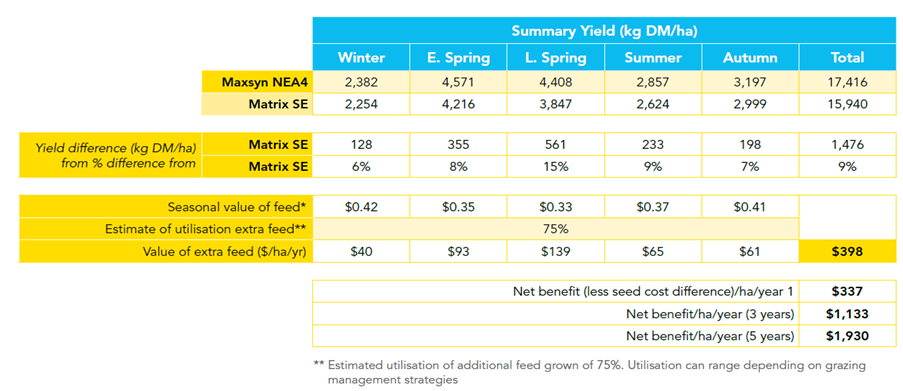
1 calculated using Dairy Australia 2023 FVI values for Gippsland, combined with an estimated 75% utilisation. 2 based on a 20 kg/ha sowing rate for a diploid perennial ryegrass. Trial data from mean of six, 3-year trials: Warragul and Howlong, 2017-2020, 2018-2021, 2019-2022. (Figure 1). Matrix SE set to the mean.
Whilst the above is one example demonstrating the benefits, the new releases are leading in their respective categories delivering additional value on farm. Whether it is 4front NEA2 delivering additional winter and early spring yield over Base AR37, to Samurye NEA12 being statistically better than Reward Endo 5 for winter, early spring and total yield, sowing Barenbrug’s new line-up will deliver you improved returns, along with peace of mind.
Not only are our varieties like Maxsyn NEA4 and Array NEA2 providing more total seasonal yield, but it is also their ability to provide a consistent seasonal growth curve that makes them standout above the rest. The graph below highlights this consistent and complimentary growth curve of Maxsyn NEA4 and Array NEA2. Against the main competitor varieties in the diploid perennial segment, Maxsyn NEA4 is superior in winter, early spring and late spring, whilst Array NEA2 while performing above Matrix SE in all seasons, still outperforms all ryegrass in this category in summer and autumn. By providing a consistent growth curve, it makes management easier whilst also reducing need for supplementary feeds at key periods during the year.

Figure: The average seasonal growth of a range of mid-late heading perennial ryegrass cultivars, relative to Matrix SE taken from trials 2016-2022.
Trial data from mean of six, 3-year trials: Warragul and Howlong, 2017-2020, 2018-2021, 2019-2022. (Figure 1). Matrix SE set to the mean.
In selecting the best variety or mix of varieties for your farm, refer to the tables below;
|
Variety |
Best for |
|
4front NEA2 |
High fertility situations; a feed quality focus; greater grazing flexibility whilst maintaining quality |
|
Array NEA2 |
Summer and autumn feed deficits; low nitrogen systems; improved utilisation |
|
Maxsyn NEA4 |
Winter and early spring feed deficits; earlier finishing paddocks; persistence |
|
Samurye NEA12 |
Maximising yield over 3-4 years; best winter and early spring production. |
|
Variety |
Ploidy |
Maturity |
Alternative to |
|
4front NEA2 |
Tetraploid |
Late |
Base AR37, Bealey NEA2, Vast AR37 |
|
Array NEA2 |
Diploid |
Late |
Expo AR37, One50, Three60 |
|
Maxsyn NEA4 |
Diploid |
Mid - Late |
Matrix SE, Hustle AR1, Platform AR37, Legion AR37 |
|
Samurye NEA12 |
Tetraploid |
Late |
Reward Endo5, Shogun NEA, Frenzy NEA, Mohaka AR37 |
Further information & supporting data on each of the varieties can be found below and by clicking on the links.
4front NEA2 Perennial Ryegrass
Through years of evaluation, 4front NEA2 has proven to be the ultimate high performance late season tetrapolid, and a new and superior successor to Bealey NEA2.
- Significantly better winter and early spring yield = increased home-grown feed over Base AR37 through critical feed deficit period
- Increased tiller density, over Base AR37 and Bealey NEA2, improving persistence
- Able to maintain higher quality pregrazing cover to provide greater grazing flexibility.
“4front NEA2 has all the benefits and features of Bealey with significantly better performance in winter and early spring. Bealey really is an exceptional grass and has been difficult to improve on. From an average seasonal yield perspective 4front offers a significant improvement over Bealey NEA2 and Base AR37 in terms of dry matter production over the cooler months. Productivity differences are less significant in late spring and summer”.
Damian Adcock, Research Agronomist – Intensive Temperate Systems
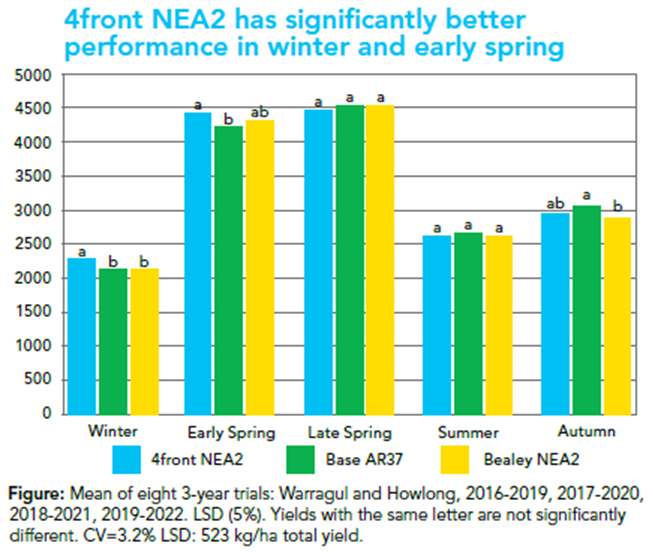
Learn more about, 4front NEA2
Maxsyn NEA4 Perennial Ryegrass
The best of all worlds: tough, dependable and high producing.
- Consistent seasonal growth, helps make Maxsyn NEA4 the highest yielding diploid cultivar on the market
- Maxsyn NEA2’s versatility and adaptability provides you with peace of mind on your farm
- Compliments the late spring, summer & autumn production of Array NEA2, with excellent cool season growth, providing consistent growth across the farm.
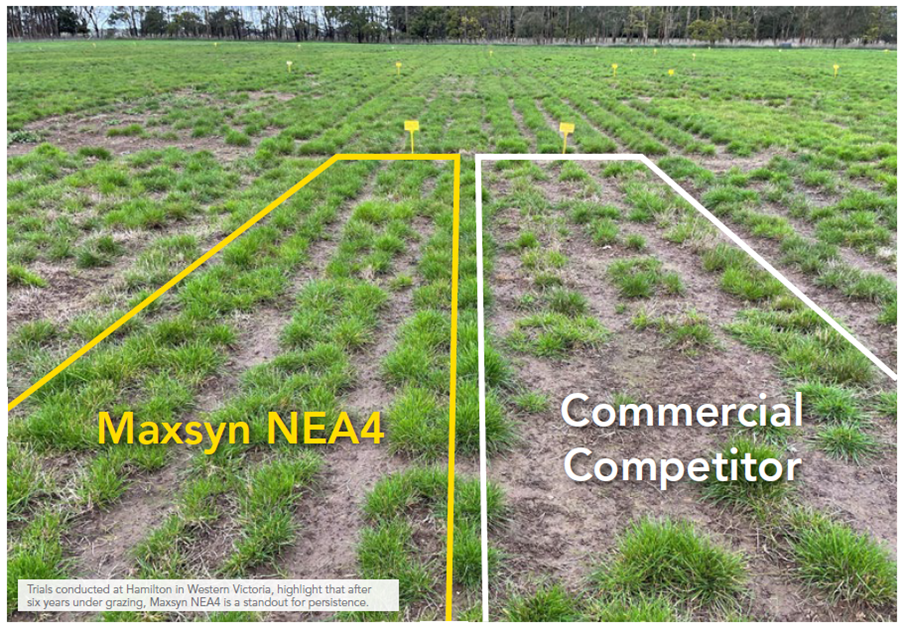
The table below also demonstrates persistence Array NEA2 compared a range of cultivars after 3 summers at Gundowring in NE Victoria under dairy grazing. Gundowring whilst being a high rainfall location (>850mm/yr.), does get pressure from summer heat and African black beetle, impacting persistence.
|
Variety |
Array NEA2 |
Maxsyn NEA4 |
Hustle AR1 |
One50 AR37 |
Matrix SE |
Victorian SE |
|
Persistence |
64% |
63% |
55% |
55% |
61% |
50% |
|
Significance |
a |
a |
ab |
ab |
a |
b |
New genetics and their quality improvement in spring
New generation varieties like Maxsyn NEA4 and Array NEA2, have demonstrated significant improvement in quality through spring, due to selection for improved quality and aspects like low aftermath heading (AMH). Varieties with Low AMH have an improvement in their ability to return to vegetative, producing high quality leafy growth, following the reproductive period in Spring.
As you will see below in the graph below, Maxsyn NEA4 has shown improved Metabolisable Energy (ME) in early and late Spring, when compared with the outdated variety, Matrix SE. This ME translates to not only improved energy, but lower Neutral Detergent Fibre (NDF) which has a big impact on dry matter intake and therefore milk production.
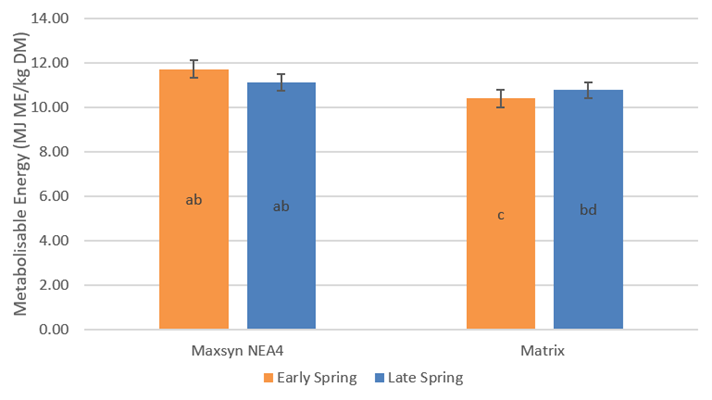
Figure: Maxsyn NEA4 demonstrates leading Metabolisable Energy (MJ ME/kg DM) in throughout spring when compared with Matrix SE. Data based on lab based NIR, taken from Warragul (VIC) during 2019 season. Data taken from replicated trials (3 reps/variety) and analysed as multiyear analysis based on 2017 & 2018 sown trials.
This improvement in spring quality translates to animal performance improvement. The table below outlines the potential additional milk solid production, assuming a constant 5.0 kg/day barley concentrate in the ration. As you can see, without accounting for additional forage yield, Maxsyn NEA4 is producing comparatively greater daily milk production, due to higher ME and greater intake. To use early Spring as an example, daily increases of Maxsyn NEA4 over Matrix SE are 0.18 kg MS/cow/day which translate to $5.45/cow/day. Over a 200 cow herd, this benefit is $1,090/day.
Table: The estimated milk production of Maxsyn NEA4 and Matrix SE assuming a constant 5 kg of barley concentrate in the diet and using analysed feed quality figures for early and late spring, from above. Milk solid production has been estimated at 8% and milk price at $8.00/kg MS.
Learn more about, Maxsyn NEA4
Array NEA2 Perennial Ryegrass
Array NEA2 is easy for your cows to eat, provides environmental credentials, along with high-quality market leading summer & autumn yield.
- Upright & densely tillered for improved harvestability from cows or fodder conservation
- Provides improved yield under low-med soil nitrogen scenarios
- Compliments the cool season production of Maxsyn NEA4 with excellent late spring, summer and autumn growth, providing consistent growth curves across the farm.
Array NEA2, a cultivar with exceptional nitrogen uptake capabilities
While we are not claiming increased “Nitrogen Use Efficiency", Array NEA2 perennial ryegrass stands out by efficiently sourcing nitrogen when soil N is low. While the mechanism is unknown, through our breeding and selection, our plant breeders have consistently tested initial selections under no artificial N application for over 30 years, which may be a contributing factor to the ability for Array to perform in these conditions.
In terms of visual impact, Array NEA2 shines in both low and high nitrogen conditions. Its standout performance can easily be observed in the trial plots with customers consistently picking out Array NEA2 in low-nitrogen scenarios.
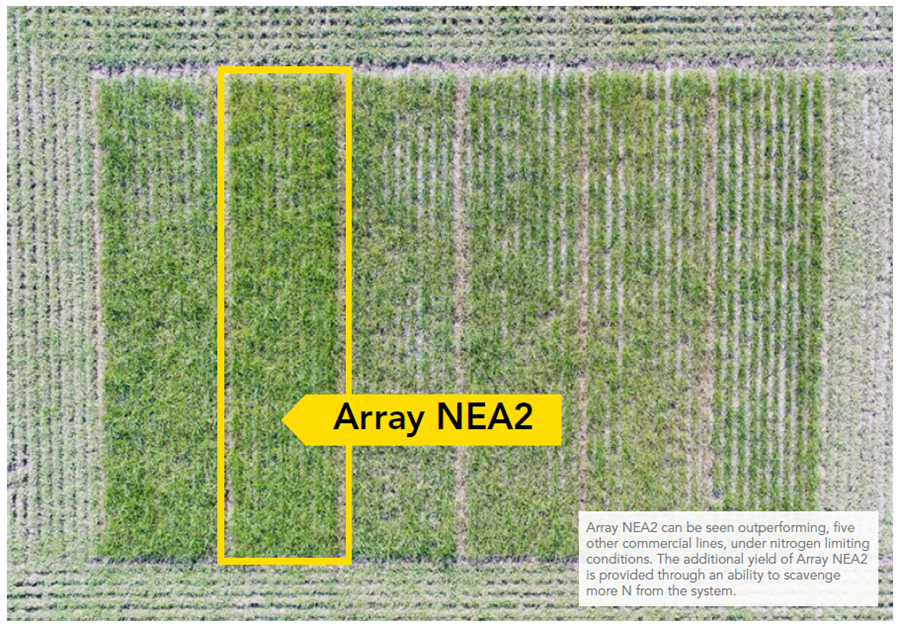
The benefits of Array become evident, particularly when nitrogen is limited. Array NEA2 excels at utilising soil nitrogen under low concentrations. As a result, growers can expect improved forage yield compared to commercial controls under N limiting conditions, which is common in most farming systems at periods during the year. This benefit has been validated through replicated trials where Array NEA2 produced 1,700 kg DM/ha more than competing cultivars, and has also been supported by anecdotal evidence from farmers.
The graph below illustrates the N balance, which is the remaining N in the system after accounting for N removed in dry matter production. It includes the available soil N from soil nitrate testing, along with applied N fertiliser. It highlights N availability, and indicates that in deficient scenarios, Array is able to scavenge more N from soil, helping promote increased DM production.
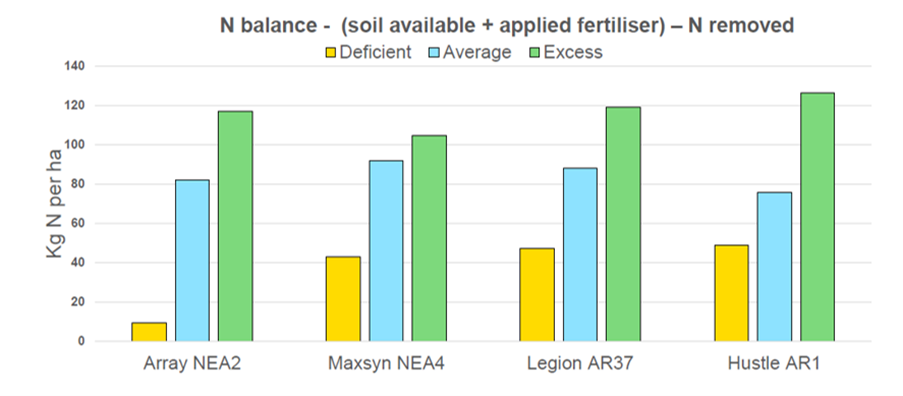
In conclusion, Array NEA2 presents an opportunity for farmers to enhance nitrogen uptake, reduce nitrate leaching and achieve improved forage yield in low-nitrogen conditions. This is whilst being a leading variety still under normal to high N concentrations.
Learn more about, Array NEA2
Samurye NEA12 Hybrid Ryegrass
Samurye NEA12 is the ultimate 3-4 year solution, maximising total and cool season yield. Shogun NEA was game changer, and Samurye NEA12 is a class above.
- Consistent seasonal performance, out-yielding all other hybrid ryegrass, to deliver more home-grown feed in the times that matter
- Combination of Samurye plus our new NEA12 endophyte provides a powerful combination driving yield, insect protection and persistence
- Provides unmatched performance in first year with short-term hybrids, whilst persisting and performing for up to 4 years.
“Samurye NEA12 just stands out every time you enter one of the trials. It always looks good. When we are measuring the trials, we see Samurye NEA12 always performing, as it tops the scales all-year round. Even just cutting it with the trials mower you can sense the machine working a bit harder in the Samurye NEA12 trial plots. Shogun is really good, but Samurye is yielding more again. This is up to 15% more in some seasons, especially from late summer, autumn through to later winter. Samurye NEA12 is really something else.”
Dustin Cundy, Farm Operations Manager – Howlong Research Farm
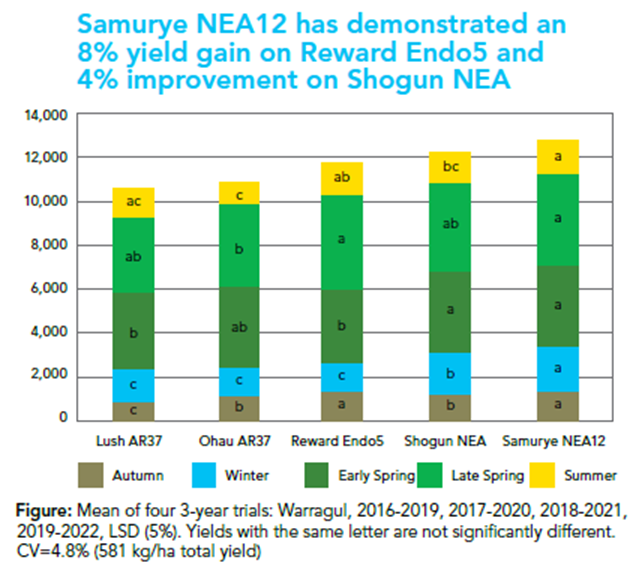
Learn more about, Samurye NEA12
For further information and assistance speak to our local Territory Manager's today.
